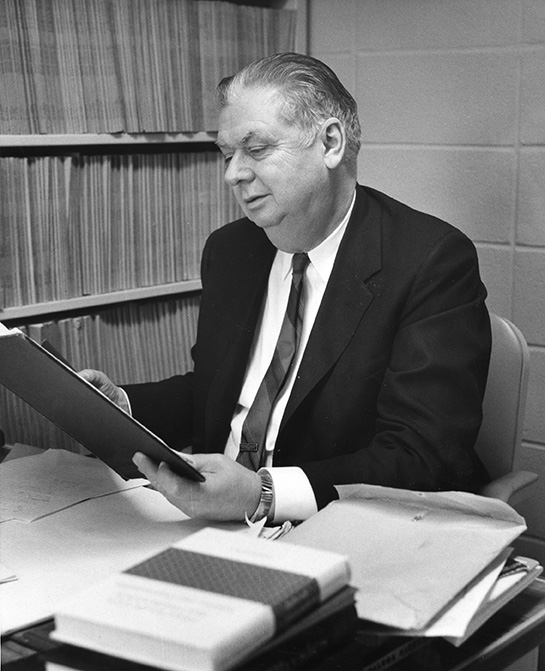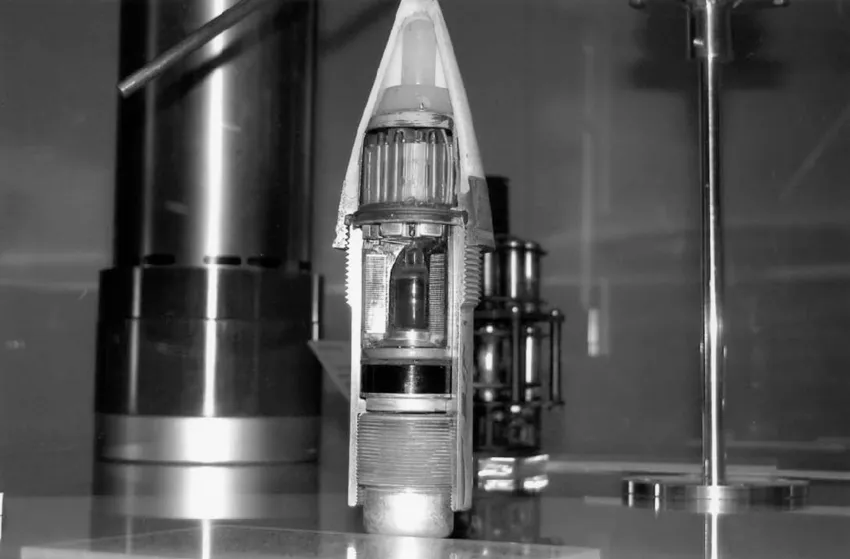‘A STEM-capable U.S. workforce is cultivated in STEM-inspired people’: How Talbott, ORISE’s first-known research program participant, inspired the world and future generations through his passion for STEM

Leo Francis Talbott, Ph.D. Photo courtesy of DeSales University.
A strong, STEM-capable workforce is critical to the United States’ global competitiveness. Yet, building and strengthening that workforce is an ever-present challenge. For Craig Layman, Ed.D., director of the Oak Ridge Institute for Science and Education’s (ORISE) STEM Workforce Development program, the answer is finding and developing people passionate about creating solutions to some of our nation’s greatest challenges.
“A STEM-capable U.S. workforce is cultivated in STEM-inspired people,” said Layman. “ORISE helps individuals find and develop their passion through hands-on, STEM-based research experiences where they can see what’s possible through STEM.” Since the late 1940s, ORISE has offered research participation and STEM workforce development programs funded by the U.S. Department of Energy (DOE) and other federal agencies.
“Dr. Leo Francis Talbott was the very definition of a STEM-inspired individual,” said Layman.
“Talbott was recognized as a pioneer in the field of nuclear physics, where his achievements brought him national and international recognition,” according to a 2021 article about the unveiling of Talbott’s portrait at DeSales University. Talbott’s name is widely known for his contributions to the design of the radio proximity fuze during World War II, an instrument that has been attributed to helping end that war. (See “Talbott and His Innovative Fuze” below).
Talbott’s name is known because of this device, but “he also holds the distinction of being ORISE’s first-known research program participant and an inspiring mentor to a new generation of nuclear physicists,” said Layman.
Talbott was a nuclear physicist and professor at both Catholic University of America and DeSales University. As the first ORISE research program participant, he was placed in the U.S. Atomic Energy Commission’s (now DOE) Laboratory Co-Op Faculty Summer Research Program at Clinton Laboratories in Oak Ridge, Tenn. (now Oak Ridge National Laboratory, or ORNL).
According to Layman, Talbott’s story is important because DOE funded and ORISE provided him the mentored research experiences that contributed to his greater understanding of the more practical applications of the nuclear science he was teaching. “Through ORISE, his research experiences could extend beyond the university setting and into the technology-rich, STEM-forward world of DOE’s national laboratories,” said Layman. “That’s a dream appointment for a nuclear physicist of his caliber.”
During that first ORISE program, June-Sept. 1947, “Talbott would have sat at the research bench alongside some of the greatest minds in nuclear science,” said Layman. “He would have performed research on the most exciting technology of the day, including experimental reactors.”
In fact, his ORISE research experiences were so valued that he participated in multiple ORISE appointments in the physics division at ORNL from 1949 to 1954, and from 1966 to 1978. “You could say Talbott’s time in ORISE programs definitely inspired him,” suggested Layman.
What makes Talbott’s story impactful is what he did next. He paid forward all that his DOE mentors had invested in him through the ORISE programs, helping ensure the next generation could propel the field of nuclear physics even farther.
After WWII, Talbott returned to Catholic University and ultimately became the institution’s first nuclear physicist and founder of its nuclear program. He was instrumental in the university receiving a grant from DOE to purchase and build a nuclear reactor on Catholic’s campus, according to The Catholic University of America Bulletin, July 1957. “It was a full-circle moment for Talbott,” said Layman. “The reactor he helped to establish at Catholic was used to teach graduate students about nuclear technology.”
Talbott taught at Catholic for 43 years before joining the DeSales University faculty. “While at [DeSales], Talbott brought hands-on experiences to the classroom,” The Morning Call wrote in its article about Talbott. “In 1970, he arranged for [ORNL’s] mobile radioisotope laboratory to visit the Center Valley campus. For two weeks, students were given access to the laboratory to study the use of radioactive materials and radioisotope instruments.” Again, Talbott’s experiences, funded by DOE through the ORISE research participation programs, “were a valued investment that he paid forward to a new generation of curious students,” said Layman.
At ORISE, Talbott will be remembered as the first participant and a significant success story in our enduring history of science education and workforce development missions. For DOE, and their long-standing commitment to funding STEM workforce development programs and inspiring the next generation of STEM professionals, Talbott embodies a strong return on investment. To Layman, that’s a great payoff. “With each research participant who comes through an ORISE program, which helps launch their STEM career or inspires them to achieve great things in science, DOE’s investment is justified, ORISE’s impact is multiplied, and the United States takes another giant leap forward in its global competitiveness.”
Talbott and his innovative fuze
 Leo Francis Talbott, Ph.D. was an educator, a renowned nuclear physicist, ORISE’s first-known research program participant, and a contributor to the development of an innovative device
Leo Francis Talbott, Ph.D. was an educator, a renowned nuclear physicist, ORISE’s first-known research program participant, and a contributor to the development of an innovative device
known as the radio proximity fuze.
According to Talbott’s obituary, he went on sabbatical during World War II from his teaching position at Catholic University to work at Johns Hopkins University in Maryland, where he helped develop the radio proximity fuze, a device instrumental in helping America and its Allies win the Battle of the Bulge.
The device used short-range Doppler radar to detect targets, like aircraft or rocket bombs, and trigger shells to explode in the air—in close proximity to their targets. The radio proximity fuze caused more damage than other fuses in conventional use, like timed fuses, which often triggered shells too soon or too late to hit their targets, or contact fuses, which required that shells hit their target directly to cause significant damage, according to Warfare History Network.
Radio proximity fuzes were first used by Americans successfully during the Battle of the Bulge, a German surprise attack launched in December 1944 in the Ardennes region of Belgium and Luxembourg. American forces fought fiercely, delaying the Germans and allowing reinforcements to arrive, which led to the Allies defeating Germany and hastened the end of the war. Radio proximity fuzes were particularly effective against German V-1 “buzz bombs,” a type of unmanned bomb also known as Adolf Hitler’s vengeance weapon, which had been used in a separate campaign from the Battle of the Bulge to wreak havoc and destruction across Europe and especially on London, according to The Man Who Calculated Death.
Talbott had received his master’s degree in 1926 and doctorate in 1928 from Catholic University, and after teaching at Catholic for 43 years, Talbott was a professor at DeSales University for eight years before retiring as physics department chairman in 1973. He then was a part-time professor there until 1977. His portrait, which hangs in the faculty suite of Dooling Hall on DeSales University’s Center Valley campus, serves as one of the few reminders of Talbott’s contributions to nuclear physics, science education and history. He was also president of Catholic University’s chapter of Sigma Xi, one of the oldest and most prestigious scientific organizations in the United States, during the 1953-54 term.
Talbott was born on July 17, 1903, in Lancaster, Ohio, and died on Christmas Day 1985 at his home in Bethlehem, Pa.
Media Contacts
Pam Bonee
Director, Communications
Phone: 865.603.5142
pam.bonee@orau.org
Wendy West
Manager, Communications
Phone: 865.207.7953
wendy.west@orau.org
The Oak Ridge Institute for Science and Education (ORISE) is a U.S. Department of Energy (DOE) asset that is dedicated to enabling critical scientific, research, and health initiatives of the department and its laboratory system by providing world class expertise in STEM workforce development, scientific and technical reviews, and the evaluation of radiation exposure and environmental contamination.
ORISE is managed by ORAU, a 501(c)(3) nonprofit corporation and federal contractor, for DOE’s Office of Science. The single largest supporter of basic research in the physical sciences in the United States, the Office of Science is working to address some of the most pressing challenges of our time. For more information, please visit science.osti.gov.

